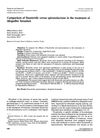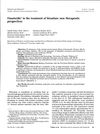Comparison of Finasteride Versus Flutamide in the Treatment of Hirsutism
October 1999
in “
European journal of endocrinology
”

TLDR Finasteride is a safe, effective treatment for hirsutism with fewer side effects.
The study compared the effectiveness of finasteride and flutamide in treating hirsutism in women with PCOS and idiopathic hirsutism. Both drugs were effective, but flutamide had more side effects, including liver toxicity and dry skin. Finasteride was better tolerated and reduced testosterone and DHT levels without affecting hematochemical parameters. Overall, finasteride was found to be a safe and effective treatment for hirsutism.











